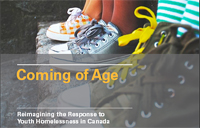What to do about youth homelessness. That is the main thrust of a new report on youth homelessness out of York University – Coming of Age: Reimagining the Response to Youth Homelessness in Canada.
It looks at not only the causes and statistics of youth homelessness, but the direction this country should be moving to help staunch the problem. It makes clear that “youth homelessness, young people between 13 and 24, is distinct from adult homelessness” in cause and consequence.
 The report, by York education Professor Stephen Gaetz, director of the Canadian Homelessness Research Network, advocates for a three-pronged strategy to dealing with the youth homelessness problem – an emphasis on prevention, emergency strategies and transition plans. Prevention strategies would include “designing and implementing effective early intervention strategies so that when young people become homeless (or are at imminent risk) they are given supports that either help them to return home or to move into new accommodation (with supports) in a safe and planned way.
The report, by York education Professor Stephen Gaetz, director of the Canadian Homelessness Research Network, advocates for a three-pronged strategy to dealing with the youth homelessness problem – an emphasis on prevention, emergency strategies and transition plans. Prevention strategies would include “designing and implementing effective early intervention strategies so that when young people become homeless (or are at imminent risk) they are given supports that either help them to return home or to move into new accommodation (with supports) in a safe and planned way.
Transition plans would include putting appropriate accommodation and supports in place. Get the youth into housing and provide needed supports – such as income and health care.
“A mature and developed response to homelessness ideally involves all three approaches, with a strong emphasis on prevention and strategies that move people quickly out of homelessness, supported by emergency services that bridge the gap,” says Gaetz.
Although there are many paths to youth homelessness, the key factors usually include individual/relational factors, structural factors, and institutional and systems failures.
“When we talk about pathways into youth homelessness, it is important to note, first, that there is a great diversity of factors that may contribute to a young person leaving home and, second, that homelessness is rarely experienced as a single event and may be the end result of a process that involves multiple ruptures with family and community and numerous episodes of leaving, even if for short periods,” states the report.
Research in Canada and the United States has found that the “majority of street youth come from homes where there were high levels of physical, sexual and emotional abuse, interpersonal violence and assault, parental neglect and exposure to domestic violence etc.”
It is also known that “childhood abuse, trauma and living in a constant state of fear have long-lasting consequences for brain development, decision-making, the formation of attachments and positive social development.”
“In addition, many young people who are homeless come from families defined by extreme poverty. This undermines the health and well-being of young people, impacts on their educational engagement and attainment, and may lead to their leaving home at an earlier age because of the inability of their parents to support them,” states the report.
Discrimination and homophobia also play a role in youth homelessness. Research has shown that more homeless youth are black, aboriginal or a sexual minority. Adding to the problem is that many children in the child welfare system are no longer provided care once they reach the age of 18, but they also don’t have homes to return to. The same lack of planning is seen in youth who have been let out of a detention centre, prison or jail.
The goal of the report is to argue for a new approach to youth homelessness. It’s intended for students, service providers, policymakers and the general public, and to help inform decision making where it counts.
For more information, visit the Homeless Hub website.



Comments are closed.